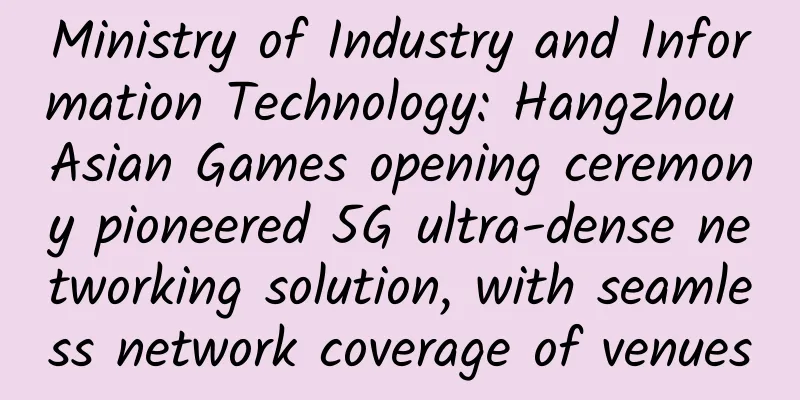5G has entered its ramp-up phase, and this key factor determines its success or failure...

|
This article is reprinted from the WeChat public account "Xianzao Classroom", the author is Xiaozaojun. Please contact the WeChat public account of Xianzao Classroom to reprint this article. In the first half of 2021, domestic 5G promotion has made good progress. According to the latest statistics from the Ministry of Industry and Information Technology, by the end of June, the number of 5G base stations in China reached 961,000, about to break the one million mark. The number of 5G terminal connections in China also soared 83.4% compared to the beginning of the year, reaching a staggering 365 million, accounting for more than 80% of the global total. As 5G is advancing by leaps and bounds, the country has made new adjustments to its 5G development strategy. In July 2021, the Ministry of Industry and Information Technology and ten other departments jointly issued the "5G Application "Sailing" Action Plan". According to this plan, the country will vigorously promote the implementation of 5G industry applications, and deeply promote new products, new formats and new models of 5G applications, providing strong support for digital transformation, intelligent upgrading and integrated innovation in various fields of the economy and society. This means that 5G has entered a real ramp-up period in the vertical industry sector. The success or failure of the ramp-up directly affects the progress and direction of this important battle of digital transformation. R16——5G’s true core capabilitiesAs we all know, 5G is divided into three major application scenarios, namely eMBB (enhanced mobile broadband), uRLLC (low latency and high reliability communication), and mMTC (massive machine type communication). eMBB is an upgrade of MBB (mobile broadband) in the 4G era, focusing mainly on indicators such as network speed, bandwidth capacity, and spectrum efficiency. The 5G mobile communications we are currently using belong to the eMBB scenario. As for uRLLC and mMTC, the former focuses on reliability and latency, while the latter focuses on the number of connections and energy consumption. Both mainly serve the industry Internet, including vertical industries such as industry, energy, logistics, education, and finance. As the developer of 5G standards, 3GPP has arranged the implementation of the above three application scenarios in two stages, namely the R15 and R16 stages that everyone is familiar with. R15 is mainly aimed at eMBB scenarios, and the standard was frozen in March 2019. R16 is aimed at uRLLC and mMTC scenarios, and the standard was frozen in July 2020. Compared with R15, which serves the consumer Internet, R16 focuses on the realization of vertical industry needs and the performance improvement of the overall 5G system. The main functions of R16 include 5G V2X for smart transportation (remote driving, autonomous driving), uRLLC enhancement for the industrial Internet, and TSN time-sensitive network. In addition, it also includes LAA, unlicensed spectrum (NR-U), positioning enhancement, MIMO enhancement, power consumption improvement, etc. The freezing of R16 means the true completion of the 5G standard, and also marks the official start of 5G's exploration of vertical industry applications. Now, a whole year has passed, and we are delighted to see that 5G has incubated a large number of lighthouse projects and established many demonstration benchmarks in industries such as industrial manufacturing, transportation ports, coal mines and oil fields, and medical health. 5G has not only promoted the digital transformation of various industries, but also stimulated the integration and innovation of the entire society and accelerated the construction of "Digital China". Recently, Unisoc and China Unicom have successfully completed the world's first end-to-end service verification of eMBB+uRLLC+IIoT based on the 3GPP R16 standard, which is of extraordinary significance. During the verification process, R16 demonstrated multiple features based on industrial Internet scenarios, including 1 microsecond high-precision timing, 1 millisecond air interface delay, end-to-end delay within 5 milliseconds, and 99.999% reliability, perfectly realizing examples such as differential protection, high-precision machine collaboration, and industrial LAN. Next, let’s take a closer look at what the enhanced features of R16 mean and what changes they will bring to the industry. Analysis of key features of R16First, let’s look at latency. What does 1 millisecond air interface delay and end-to-end delay within 5 milliseconds mean? Our traditional 4G LTE network generally has a latency of tens of milliseconds. Although it seems to be very low, it is still not enough for industrial manufacturing and smart grids. In "control theory", latency is a very critical parameter. A higher network latency means a slower system response speed, lower control accuracy, and reduced efficiency. For example, robot single-point welding or paint spraying scenarios in industrial manufacturing. First, we need to use a camera to monitor and locate the welding points that need to be welded or the places that need to be painted. After the camera obtains the data, it is uploaded to the cloud for processing, and then the cloud issues instructions to the robot arm to complete the welding or painting operation. If the network latency is too high, the entire operation time will increase, efficiency will decrease, and it may even increase the defective rate, thereby increasing the cost of the enterprise. For the Internet of Vehicles, latency is an even more sensitive indicator. For a car traveling at 120 kilometers per hour, every extra 10 milliseconds of latency means an extra 33.3 centimeters of braking distance, which may determine the safety of a person's life. In addition to pursuing extremely low latency, we must also ensure its stability. In other words, the jitter value of latency must be controlled within a stable range. Otherwise, it will cause a series of efficiency, quality and security problems. 5G improves reliability from 99.9% to 99.999%, mainly based on designs such as channel redundant transmission. The improvement in reliability means that 5G can be applied to more scenarios. The third point is high-precision time synchronization. High-precision timing is a 5G feature that is easily overlooked. Many people do not understand why timing is necessary and what is the significance of timing with microsecond accuracy. In fact, the role of timing is very simple, which is to serve the collaboration between different objects. Through high-precision timing, the robotic arms and robotic arms, AGVs (unmanned vehicles) and AGVs can be perfectly synchronized and seamlessly connected. Another classic scenario for high-precision timing is the smart grid. As we all know, the power grid uses alternating current, and the direction of the current changes with time. When different power grid equipment is connected to the grid, if the timing is inconsistent, the peaks and troughs will be inconsistent, which may cause unnecessary energy loss at best, or even a direct short circuit, damage to equipment, paralyze the power grid, and cause a large-scale power outage. In addition, for the power grid's relay protection devices, automation devices, energy management systems, etc., high-precision timing can better meet the time consistency requirements for event sequence recording, fault recording, and real-time data collection, ensuring the accuracy of line fault ranging, dynamic monitoring of phase quantities and power angles, and unit and power grid parameter verification. Finally, let’s take a look at 5G LAN. 5G LAN is actually a 5G private network technology, which is equivalent to sinking the public network deployment method. In the park, a "local area network (LAN)" scenario is built through the 5G protocol, allowing different devices to communicate with each other easily. This technology not only significantly reduces network deployment costs and shortens network construction cycles, but also meets the needs of many enterprise users to keep data within the factory, enhancing security and privacy. Combined with edge computing technology, 5G LAN can provide users with a low-latency, high-reliability private network to ensure the steady advancement of intelligent manufacturing. The key to 5G's success lies in chipsThe enhanced features brought by the R16 standard have laid a solid foundation for 5G to empower hundreds of industries and also created good conditions for the birth of a digital industrial ecosystem. However, it is not an easy task to truly implement 5G applications in vertical industries and tap the full potential of R16. Why do Ziguang ZTE and China Unicom need to conduct end-to-end business verification? It is precisely because of the comprehensive end-to-end capability improvement that the wooden barrel effect can be eliminated and the true 5G can be demonstrated. According to China Unicom, comprehensive capabilities include five core elements: “end, network, cloud, edge, and industry.” Among them, the most basic is “end (terminal)”. The terminal is the nerve ending of the Internet of Things. It is responsible for sending sensor data to the network and cloud center. The control instructions of the cloud center also need to be conveyed to the device through it to realize the control intention. The arrival of 5G not only tests the network, but also the terminals. The characteristics of 5G R16, such as large bandwidth, low latency, and high reliability, require the terminals to significantly improve their performance and fully match the characteristics of R16. Who determines the performance of the terminal? That's right, after much deliberation, we finally found the key to the problem, that is - the chip. If we want to realize the "Internet of Everything", we must first realize "everything has a chip". Compared with "network" and "cloud", we face a more severe situation in the field of "chip". For reasons known to all, there are only four baseband chip players with 5G capabilities in the global open market, namely Qualcomm, Samsung, MediaTek, and Spreadtrum. Spreadtrum is the only Chinese mainland company. In recent years, the country has continuously increased its attention and investment in the chip semiconductor industry, and the domestic industrial ecology has been significantly improved. However, the competition in the chip field is a protracted battle. If we want to achieve the final victory, we still have a long way to go. In short, the success or failure of 5G lies in the industry, the foundation of the industry lies in the terminal, and the lifeblood of the terminal lies in the chip. Only when chip companies rise can we increase our hard power in the global digital industrial revolution, ensure the steady development of the digital economy, and ultimately succeed in digital transformation. The road to chips is long and tortuous, and Chinese people should forge ahead and explore! |
<<: The Central Cyberspace Affairs Commission: The number of active IPv6 users reached 528 million
>>: Beijing: 63,000 5G base stations will be put into operation by 2025
Recommend
Aruba CX Next-Generation Switching Platform Launches to Provide New Network Experience from Edge to Cloud
On December 18, 2019, Aruba, a subsidiary of Hewl...
UCloud Double 11 Carnival, AMD models are replenished in large quantities, Hong Kong 2C4G2M cloud server starts at 287 yuan/year
UCloud's Golden Autumn Carnival event has end...
Huawei launches LampSite X indoor digital innovation solution to unleash the unlimited potential of the digital world
[Dubai , UAE , October 11, 2023 ] During the 2023...
Huawei's Yu Chengdong: This is a truly global mobile Internet cloud service
Normal 0 7.8 磅 0 2 false false false EN-US ZH-CN ...
Job hunting winter Internet companies even outsource architects with a monthly salary of 80,000 yuan
[[251420]] On the one hand, the number of employe...
RAKsmart: 35% off VPS hosting/30% off cloud servers, US/Japan/Korea/Hong Kong VPS monthly payment starting from $1.95, CN2/AS9929, etc.
RAKsmart's year-end discount is coming. In ad...
Looking at Huawei in the 5G era, which of the 149 suppliers can achieve success?
The past of Apple’s industrial chain may very wel...
The three major operators announced their performance at the beginning of the year!
Recently, the three major operators have successi...
How long will it take for 5G small base stations to "take off"?
In the era of rapid changes in information and co...
Kubernetes Gateway API v1.1 Interpretation, do you understand it?
A few days ago, the K8s Network SIG released the ...
Still using OpenFeign? Try this new thing in SpringBoot3!
The New Year is over, and Brother Song has been m...
Runqian Software and Yonghong Technology signed a strategic cooperation agreement
[51CTO.com article] On November 8, 2017, Runqian ...
edgeNAT newly launched South Korea SK direct connection VPS with 20% discount on monthly payment and 30% discount on annual payment, 2G memory package starts at 48 yuan/month
edgeNAT has newly launched the Korean three-netwo...
Six key trends in network management
We live in an era of rapid development of IT tech...
What is the use of airplane mode? What will happen if you don't turn it on when flying?
Everyone knows that when flying, you should turn ...









